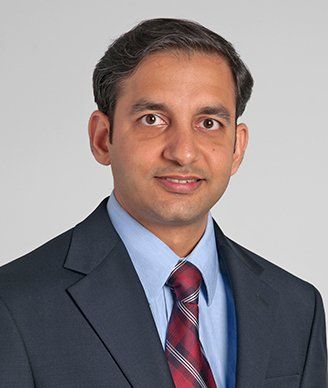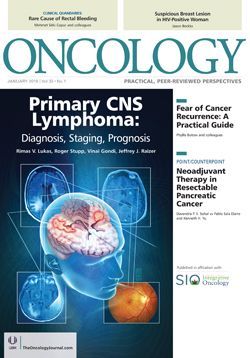POINT: Weighing the Risks and Benefits of Neoadjuvant Therapy in Resectable Pancreatic Cancer
ASCO clinical practice guidelines recommend resection followed by treatment with gemcitabine and capecitabine as the standard of care; however, neoadjuvant therapy is also considered an appropriate alternative.
Oncology (Williston Park). 32(1):39-41, 44.

Davendra P. S. Sohal, MD, MPH

Early, Aggressive Neoadjuvant Therapy Is Appropriate in Selected Patients
The treatment of resectable pancreatic cancer-pancreatic ductal adenocarcinoma-involves surgical resection and adjuvant chemotherapy. The American Society of Clinical Oncology clinical practice guidelines recommend resection followed by treatment with gemcitabine and capecitabine as the standard of care; however, neoadjuvant therapy is also considered an appropriate alternative.[1,2] Given the choice between neoadjuvant and adjuvant management in this setting, it is important to review the evidence behind each claim.
The standard of care, of course, has been surgical resection; since most pancreatic cancers present in the head of the organ, the Whipple operation is the main surgical procedure. Historically, adjuvant chemotherapy with either gemcitabine or fluorouracil (5-FU) was the accepted postoperative approach. More recently, however, the ESPAC-4 study showed that combination chemotherapy with gemcitabine plus capecitabine leads to improved overall survival (28.0 months vs 25.5 months with single-agent gemcitabine),[3] making it the new standard of care.
I would argue, though, that there is clearly room to improve the management of resectable pancreatic cancer, and that we have enough data now to support the systematic use of neoadjuvant therapy in this setting, ideally in the context of a trial. Outside of a controlled clinical investigation, neoadjuvant treatment of resectable pancreatic cancer should at least be administered at a high-volume center, as part of a multidisciplinary program, to allow careful selection of patients and treatment regimens. In addition, patients should be carefully followed after the conclusion of treatment, so that outcomes of neoadjuvant therapy can be evaluated. Data supporting the concept of neoadjuvant therapy in resectable pancreatic cancer stem from preclinical studies demonstrating the systemic natural history of pancreatic cancer even at its earliest stages, as well as clinical series showing adverse outcomes due to systemic rather than locoregional recurrences.[4] While the rate of perioperative mortality in patients with resectable pancreatic cancer treated at high-volume centers is currently very low, overall cure rates remain dismal.
The way forward is to administer systemic therapy earlier and more aggressively. The ideal platform is neoadjuvant therapy, if one considers the following:
• A surgery-first approach can delay systemic disease control by about 2 months (due to the time required for the preoperative workup and the scheduling of surgery, as well as allowing adequate postoperative recovery before initiation of multiagent chemotherapy).
• Use of more aggressive systemic therapy postoperatively-such as the regimen of folinic acid, 5-FU, irinotecan, and oxaliplatin (FOLFIRINOX) or combination treatment with gemcitabine and nab-paclitaxel-is hampered by the associated toxicities. In ESPAC-4, which established gemcitabine and capecitabine as the new standard of adjuvant care for patients with resectable pancreatic cancer, only 54% of patients completed their treatment course of combination adjuvant chemotherapy.[3] A similar experience was noted with use of the Medical Research Council Adjuvant Gastric Infusional Chemotherapy, or MAGIC, trial regimen (epirubicin, cisplatin, and 5-FU) in patients with gastric cancer; only 42% completed the same course of adjuvant therapy that they had successfully received preoperatively.[5]
• Downstaging of tumors is more likely following neoadjuvant therapy compared with upfront resection, due to increased odds of obtaining margin-negative resections. While the ability to achieve negative resection margins may be even greater with use of neoadjuvant regimens employing radiation, the rates of response to chemotherapy in the pivotal studies of FOLFIRINOX and combination therapy with gemcitabine and nab-paclitaxel in the metastatic setting indicate that we can hope to see 1 in 4 patients or even 1 in 3 patients experiencing a radiologic response to treatment.[6,7]
• Early identification of therapeutic failures-due to physiology (when patients cannot tolerate the chemotherapy regimen) or biology (when disease progresses despite the administration of chemotherapy)-spares selected patients from undergoing major abdominal surgery that is unlikely to be of benefit.
• Prospective evaluation of blood and tissue is needed to identify prognostic and predictive biomarkers in this disease; currently there is no biomarker to guide therapeutic decisions in pancreatic cancer.[1,8] It is hoped that in the near future, patients’ response to treatment will be assessable in vivo, allowing modification of a given therapeutic approach based on accumulated prospective data.
The results of ongoing large multi-institutional prospective studies of neoadjuvant therapy for resectable pancreatic cancer may ultimately provide evidence in support of many of the previously mentioned considerations. At this time, the two main objections to the use of neoadjuvant therapy for resectable pancreatic cancer are the lack of a solid body of evidence to support this approach, and the fact that neoadjuvant administration of treatment delays potentially curative surgical resection. Current evidence favoring the neoadjuvant approaches comes from smaller, mostly single-institution studies, many of which used single-agent chemotherapy in conjunction with radiation. Therefore, it is difficult to draw firm conclusions that will apply to the current age of multiagent chemotherapy regimens in pancreatic cancer. Nonetheless, we understand that a large majority (80% to 90%) of patients receiving neoadjuvant therapy for resectable pancreatic cancer are eventually able to undergo surgical resection.[9-14] While it is certainly unsettling to both patients and their doctors to delay management of a resectable cancer, accumulated evidence for solid tumors has not shown any detrimental outcomes with neoadjuvant therapy and delayed resection.[5,15] In the subgroup of patients with resectable pancreatic cancer who have completed both neoadjuvant therapy and resection, overall survival reaches a median of 20 to 24 months; notably, single-agent chemotherapy with radiation was the treatment approach followed in most of these studies.[16,17]
There are obvious caveats, however. The first step after a tissue diagnosis is staging, and in pancreatic cancer, an important component of management is to ascertain resectability. In the Intergroup setting of the National Cancer Institute’s National Clinical Trials Network, the accepted definition is now based on an interface between tumor and vessel wall, using degrees of circumference of the vessel wall as seen on cross-sectional (axial) imaging.[18] This is a shift from the somewhat subjective descriptors such as abutment, impingement, involvement, and others. A multidisciplinary approach at a high-volume center is preferred. The role of baseline diagnostic laparoscopy in determining resectability is not established; growing evidence appears to support its use, as a number of patients may have occult metastatic disease and this finding can help these patients avoid the toxicities and costs of futile therapy.[19] The optimal duration of neoadjuvant therapy is not clear; most studies are using 3 months, since both maximal tolerance and benefit may peak around that time, and further prolongation of chemotherapy or chemoradiation may only delay curative resection. It is arguable that any approach within this framework is acceptable, as long as it is systematic, as previously discussed.
Of course, we eagerly await the results of large clinical trials to provide better answers to these questions. Key investigations to follow are the Southwest Oncology Group S1505 trial (ClinicalTrials.gov identifier: NCT02562716) in the United States, evaluating FOLFIRINOX vs the gemcitabine/nab-paclitaxel combination as perioperative regimens; the NEOPAC study (ClinicalTrials.gov identifier: NCT01521702) in France, which has completed accrual and will evaluate neoadjuvant therapy with gemcitabine plus oxaliplatin; the two German trials, NEPAFOX (ClinicalTrials.gov identifier: NCT02172976), testing perioperative FOLFIRINOX, and NEONAX (ClinicalTrials.gov identifier: NCT02047513), testing perioperative gemcitabine/nab-paclitaxel; and PACT-15 (ClinicalTrials.gov identifier: NCT01150630), the Italian study of an aggressive perioperative regimen comprising gemcitabine, cisplatin, epirubicin, and capecitabine. Taken together, these trials are enrolling several thousand patients, with primary endpoints of overall survival or disease-free survival. It is anticipated that the outcomes will help shed light on the safety of neoadjuvant therapy, as well as on the impact of this strategy on surgical and survival outcomes. While it may be challenging to identify the optimal regimen, I believe that these studies will yield enough evidence to support widespread use of neoadjuvant therapy for resectable pancreatic cancer. This will allow us to move forward to the next step: integrating targeted therapies, immunotherapies, and other novel agents into the treatment approach, guided by our rapidly growing understanding of the biology of pancreatic cancer.[20,21]
Financial Disclosure:The author has no significant financial interest in or other relationship with the manufacturer of any product or provider of any service mentioned in this article.
References:
1. Khorana AA, Mangu PB, Berlin J, et al. Potentially curable pancreatic cancer: American Society of Clinical Oncology clinical practice guideline. J Clin Oncol. 2016;34:2541-56.
2. Khorana AA, Mangu PB, Berlin J, et al. Potentially curable pancreatic cancer: American Society of Clinical Oncology clinical practice guideline update. J Clin Oncol. 2017;35:2324-8.
3. Neoptolemos JP, Palmer DH, Ghaneh P, et al. Comparison of adjuvant gemcitabine and capecitabine with gemcitabine monotherapy in patients with resected pancreatic cancer (ESPAC-4): a multicentre, open-label, randomised, phase 3 trial. Lancet. 2017;389:1011-24.
4. Sohal DP, Walsh RM, Ramanathan RK, Khorana AA. Pancreatic adenocarcinoma: treating a systemic disease with systemic therapy. J Natl Cancer Inst. 2014;106:dju011.
5. Cunningham D, Allum WH, Stenning SP, et al. Perioperative chemotherapy versus surgery alone for resectable gastroesophageal cancer. N Engl J Med. 2006;355:11-20.
6. Conroy T, Desseigne F, Ychou M, et al. FOLFIRINOX versus gemcitabine for metastatic pancreatic cancer. N Engl J Med. 2011;364:1817-25.
7. Von Hoff DD, Ervin T, Arena FP, et al. Increased survival in pancreatic cancer with nab-paclitaxel plus gemcitabine. N Engl J Med. 2013;369:1691-703.
8. Sohal DP, Mangu PB, Khorana AA, et al. Metastatic pancreatic cancer: American Society of Clinical Oncology clinical practice guideline. J Clin Oncol. 2016;34:2784-96.
9. Evans DB, Varadhachary GR, Crane CH, et al. Preoperative gemcitabine-based chemoradiation for patients with resectable adenocarcinoma of the pancreatic head. J Clin Oncol. 2008;26:3496-502.
10. O’Reilly EM, Perelshteyn A, Jarnagin WR, et al. A single-arm, nonrandomized phase II trial of neoadjuvant gemcitabine and oxaliplatin in patients with resectable pancreas adenocarcinoma. Ann Surg. 2014;260:142-8.
11. Palmer DH, Stocken DD, Hewitt H, et al. A randomized phase 2 trial of neoadjuvant chemotherapy in resectable pancreatic cancer: gemcitabine alone versus gemcitabine combined with cisplatin. Ann Surg Oncol. 2007;14:2088-96.
12. Pisters PW, Wolff RA, Janjan NA, et al. Preoperative paclitaxel and concurrent rapid-fractionation radiation for resectable pancreatic adenocarcinoma: toxicities, histologic response rates, and event-free outcome. J Clin Oncol. 2002;20:2537-44.
13. Van Buren G 2nd, Ramanathan RK, Krasinskas AM, et al. Phase II study of induction fixed-dose rate gemcitabine and bevacizumab followed by 30 Gy radiotherapy as preoperative treatment for potentially resectable pancreatic adenocarcinoma. Ann Surg Oncol. 2013; 20:3787-93.
14. Varadhachary GR, Wolff RA, Crane CH, et al. Preoperative gemcitabine and cisplatin followed by gemcitabine-based chemoradiation for resectable adenocarcinoma of the pancreatic head. J Clin Oncol. 2008;26:3487-95.
15. van Hagen P, Hulshof MC, van Lanschot JJ, et al. Preoperative chemoradiotherapy for esophageal or junctional cancer. N Engl J Med. 2012;366:2074-84.
16. Andriulli A, Festa V, Botteri E, et al. Neoadjuvant/preoperative gemcitabine for patients with localized pancreatic cancer: a meta-analysis of prospective studies. Ann Surg Oncol. 2012;19:1644-62.
17. Gillen S, Schuster T, Meyer Zum Büschenfelde C, et al. Preoperative/neoadjuvant therapy in pancreatic cancer: a systematic review and meta-analysis of response and resection percentages. PLoS Med. 2010;7:e1000267.
18. Katz MH, Marsh R, Herman JM, et al. Borderline resectable pancreatic cancer: need for standardization and methods for optimal clinical trial design. Ann Surg Oncol. 2013;20:2787-95.
19. Peng JS, Mino J, Monteiro R, et al. Diagnostic laparoscopy prior to neoadjuvant therapy in pancreatic cancer is high yield: an analysis of outcomes and costs. J Gastrointest Surg. 2017;21:1420-7.
20. Bailey P, Chang DK, Nones K, et al. Genomic analyses identify molecular subtypes of pancreatic cancer. Nature. 2016;531:47-52.
21. Cancer Genome Atlas Research Network. Integrated genomic characterization of pancreatic ductal adenocarcinoma. Cancer Cell. 2017;32:185-203.
